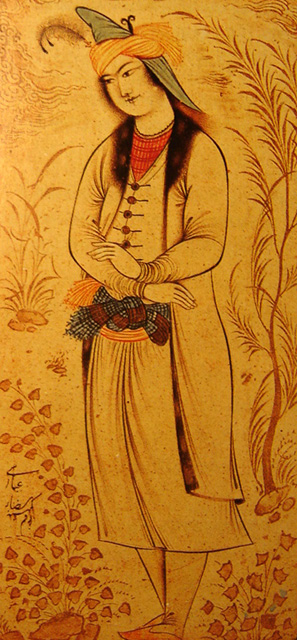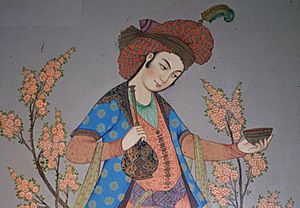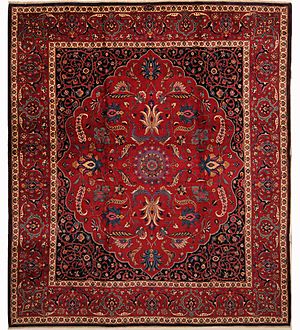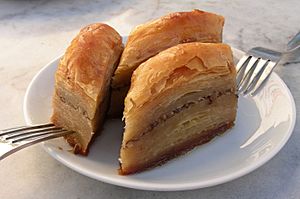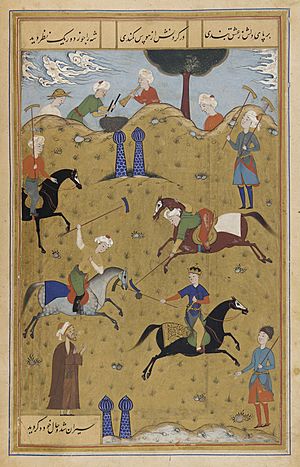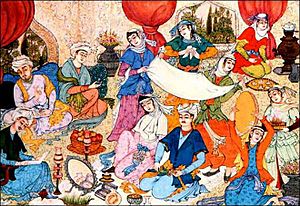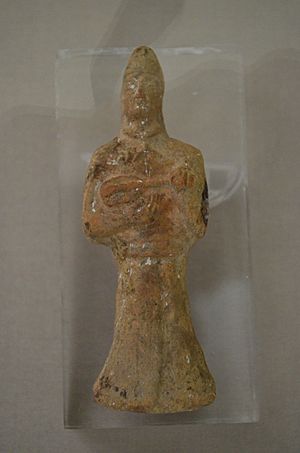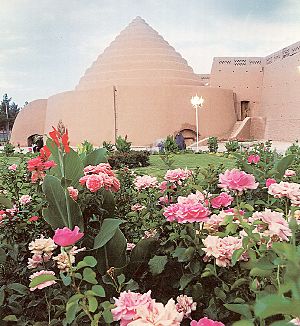Culture of Iran facts for kids
The culture of Iran (also known as the culture of Persia) is one of the oldest in the world. Iran has been very important in history, influencing many cultures and people. Its reach spread from Italy and Greece in the West, to Russia in the North, the Arabian Peninsula in the South, and South and East Asia in the East.
This shows that Iran's culture is very flexible and has lasted a long time. The culture of Iran has also shaped areas like the Caucasus, Central Asia, Anatolia, and Mesopotamia.
Contents
Exploring Iranian Art and Creativity
Iran has an amazing history of art. It includes many different types of art like architecture (building design), painting, weaving (like carpets), pottery, calligraphy (beautiful writing), metalworking, and stonemasonry (working with stone). Today, there's also a lively Iranian modern and contemporary art scene.
Iranian art has changed a lot over time. When Islam became popular, it brought big changes to art styles and how art was made.
Understanding Religion in Iran
Zoroastrianism was the main religion in Iran for over a thousand years before the Arab conquest. This ancient faith had a huge impact on Iranian philosophy, culture, and art. Later, most people in Iran changed their religion to Islam.
Today, about 98% of people in Iran are Muslims. Of these, around 89% follow Shi’a Islam, and about 9% follow Sunni Islam.
The Beauty of Persian Rugs
In Iran, Persian rugs are a very important part of the culture.
Iranians were among the first people in history to weave carpets. At first, these rugs were made for a simple reason: to help nomadic people in ancient Iran stay warm from the cold ground. Over time, rugs became more complex and beautiful. Now, they are often bought as decorative art pieces.
Because of the long history of weaving fine silk and wool rugs in Iran, Persian rugs are famous worldwide. They are known for being some of the most beautiful and detailed rugs available. In many parts of Iran, rugs are highly valued possessions. Iran actually makes more rugs and carpets than all other countries in the world combined!
Modern Iranian Culture and Arts
Iranian Cinema: Movies from Iran
Iranian films have won over 300 international awards in the last 10 years. This shows how much they are enjoyed and recognized around the world.
Modern Art in Iran
There is a growing interest in modern Iranian artists, as well as artists from the larger Iranian community living outside Iran.
The Sounds of Persian Music
The history of Persian music goes back a very long time, even before the time of Barbod in the royal Sassanid courts. Many other music cultures can trace their beginnings to this ancient music.
Iranian Architecture: Buildings and Gardens
Traditional Tea-Houses: A Place to Relax
You can find countless traditional tea-houses (called chai khooneh) all over Iran. Each region has its own special way of presenting this old tradition. However, some things are common everywhere. These include strong chai (tea) and the ever-present ghalyan hookah. Most tea-houses also serve baqleh, which are steamed fava beans with salt and vinegar. They also offer various desserts and pastries. Many tea-houses even serve full meals, like different kinds of kebabs and local dishes.
Persian Gardens: Paradise on Earth
The idea behind a Persian garden was to create a reflection of paradise on Earth. The word "garden" itself comes from Persian roots! You can see how important gardens are to Iranians in their buildings, old ruins, and paintings.
Iranian Cuisine: Delicious Foods
Iranian food is considered one of the oldest types of cooking in the world. Bread is perhaps the most important food in Iran. There are many different kinds of bread, like nan and hamir, which are baked in large clay ovens called "tenurs."
Many Iranian dishes use dairy products. One very popular one is yogurt ("mast"). It has a special way of being made that many Iranians use. Yogurt is also used to make soup and is important for producing oil.
Besides dairy, Iranian cooking uses a lot of rice dishes. Some popular ones include boiled rice with meats, vegetables, and seasonings ("plov"). Examples are chelo-horesh, shish kebab with rice, chelo-kebab, rice with lamb, meatballs with rice, and kofte (plain boiled rice).
Iranian food is also famous for its sweets. One of the most well-known is "baklava" with almonds, cardamom, and egg yolks. Iranian sweets often use honey, cinnamon, lime juice, and sprouted wheat grain. A popular dessert drink, "sherbet sharbat-portagal," is made from orange peel and juice boiled in sugar syrup, then mixed with rose water. Like many people in the Middle East, Iranians prefer to drink tea (without milk) or "kakhve-khana."
Sports in Iran
The game of Polo started with Iranian tribes a very long time ago. It was played regularly across the country until 1979. After that, it became less common because it was linked to the monarchy. Polo is still played, but mostly in rural areas and quietly. However, since 2005, it has become more popular again. In March 2006, there was a big tournament that was shown on TV.
Traditional Iranian Holidays
Iranians celebrate these holidays based on a solar calendar. They also celebrate important religious days from the Islamic and Shia calendars, which follow a lunar calendar.
- Nowruz (Iranian New Year) - Starts on March 21
- Sizdah be dar (Nature Day)
- Jashn-e-Tirgan (Water Festival)
- Jashn-e-Sadeh (Fire Festival)
- Jashn-e-Mehregan (Autumn Festival)
- Shab-e-Yalda (Winter Feast)
- Charshanbeh Suri
Iran's Gifts to the World (Ancient History)
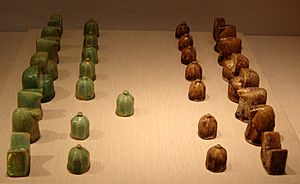
From the simple brick to the windmill, people from Greater Iran have combined creativity with art to give the world many amazing things. Here are just a few examples:
- (10,000 BC) - The earliest known time when goats were tamed.
- (6000 BC) - The modern brick. Some of the oldest bricks ever found are Persian, from around 6000 BC.
- (5000 BC) - The invention of wine. This was discovered by scientists digging at Hajji Firuz Tepe in northwestern Iran.
- (5000 BC) - The invention of the Tar (lute), a musical instrument that helped lead to the development of the guitar.
- (3000 BC) - A game like backgammon appeared in eastern Iran.
- (1400 BC - 600 BC) - Zoroastrianism: Some scholars believe this was the first religion with a single prophet.
- (576 BC - 529 BC) - The Cyrus Cylinder: This is seen as the world's first document about human rights.
- (521 BC) - The game of Polo.
- (500 BC) - The first banking system in the world. During the Achaemenid Empire, government banks helped farmers with loans during droughts or floods.
- (500 BC) - The word "Check" has Persian roots. This type of document was used for money value from Achaemenid times until the end of the Sassanian Empire.
- (500 BC) - The world's oldest staple.
- (500 BC) - The first tax system (under the Achaemenid Empire).
- (500 BC) - The "Royal Road" - the first postal service.
- (500 BC) - The domesticated chicken was introduced to Europe from Persia.
- (500 BC) - The first time spinach was grown.
- (400 BC) - Yakhchals, ancient refrigerators. (See picture above)
- (400 BC) - Ice cream.
- (50 AD) - Peaches, originally from China, came to the West through Persia. This is why their Latin name is Prunus persica.
- (271 AD) - Academy of Gundishapur - Considered the first hospital.
- (700 AD) - The cookie.
- (700 AD) - The windmill.
- (864 AD - 930 AD) - Rhazes was the first to use alcohol in medicine in a systematic way.
- (1000 AD) - Tulips were first grown in medieval Persia.
- (1000 AD) - Paper was introduced to the West from Persia.
- (935 AD - 1020 AD) - Ferdowsi wrote the Shahnama (Book of Kings), which helped bring back Iranian culture.
- (980 AD - 1037 AD) - Avicenna, a doctor, wrote The Canon of Medicine, a very important book in the history of modern medicine.
- (1048 AD - 1131 AD) - Khayyam, a brilliant scholar, suggested that the Earth goes around the Sun (a theory called heliocentricity). He also made important contributions to algebra.
- (1207 AD - 1273 AD) - Rumi wrote famous poetry.
- Algebra and Trigonometry: Many Iranians helped create Algebra, improve Medicine and Chemistry, and discover Trigonometry.
- Qanat, underground water channels.
- Wind catchers, ancient air conditioning systems for homes.
Images for kids
-
Intricate stone art of Persepolis
-
Shah Mosque, Isfahan
See also
 In Spanish: Cultura de Irán para niños
In Spanish: Cultura de Irán para niños


